Translate this page into:
Combination of two types of nail brace for the treatment of complicated ingrown toenails
2 Department of Dermatology, Wan Fang Hospital, Taipei Medical University, Taipei City; Department of Dermatology, School of Medicine, College of Medicine, Taipei Medical University, Taipei City, Taiwan
Correspondence Address:
Yu-Chen Huang
Department of Dermatology, Wan Fang Hospital, Taipei Medical University, 111, Xinglong Road Section 3, Wenshan District, Taipei City 116
Taiwan
| How to cite this article: Liu CW, Huang YC. Combination of two types of nail brace for the treatment of complicated ingrown toenails. Indian J Dermatol Venereol Leprol 2017;83:722-725 |
Sir,
Ingrown toenails are common and greatly impact the daily activities and cause discomfort. Here, we report two complicated cases of ingrown toenails treated with a combination of two types of nail braces in the Wan Fang Hospital, Taiwan. This report was approved by the joint institutional review board of Taipei Medical University.
Before applying the nail brace, we removed a minimal portion of the ingrown nail. No anesthesia was administered. The Podofix brace (3TO, Deisenhofen, Germany) comprises an elastic plastic pad and activating wire. The brace is glued to the nail and then activated by twisting the integrated loop. The excess wire is trimmed, and the gel depot of the brace is sealed by nail gel. The COMBIped brace (3TO, Deisenhofen, Germany) comprises two sides – one side of the brace is a spring wire and the other is fitted with a plastic pad. The wire is then shaped into a hook. The hook is attached to one side of the nail rim, and the pad is fixed to the nail using glue. Finally, the pad is sealed with nail gel.
A 40-year-old man presented with a grade II ingrown toenail on the medial side of the left toenail [Figure 1a]. The COMBIped brace was applied, and the pain immediately resolved. However, granulation tissue progressed after 2 weeks owing to irritation from the wire [Figure 1b]. We removed the COMBIped brace, applied the Podofix brace with gauze insertion to avoid irritation [Figure 1c]. A new COMBIped brace was added after the granulation tissue resolved completely [Figure 1d]. The patient wore this nail brace for 5 months without discomfort, and the nail brace dropped off along with the nail growth. The pain resolved, and the shape of nail improved. There was no recurrence during the 4-month follow-up period [Figure 1e].
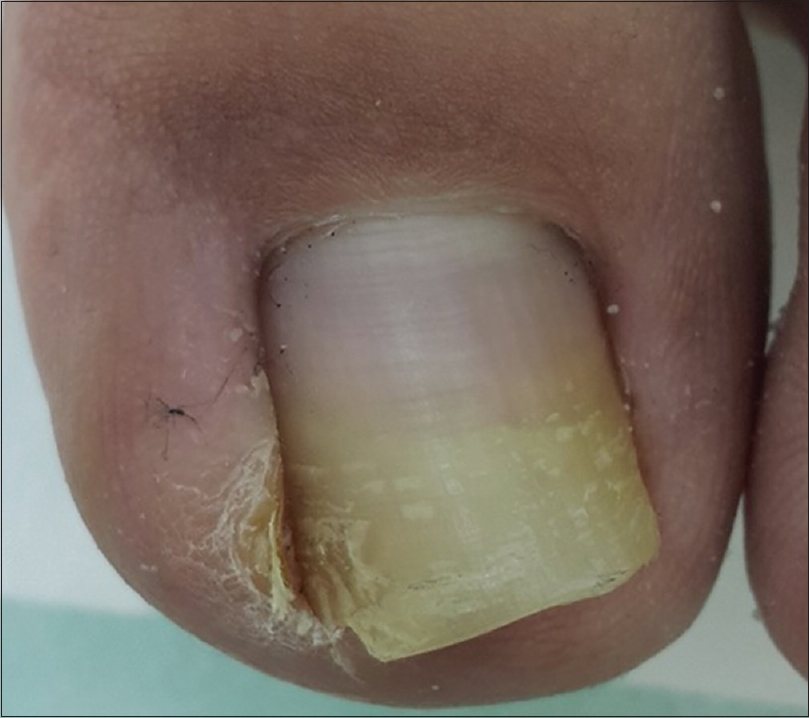 |
| Figure 1a: Grade II ingrown toenail on the medial side of the left toenail (before therapy) |
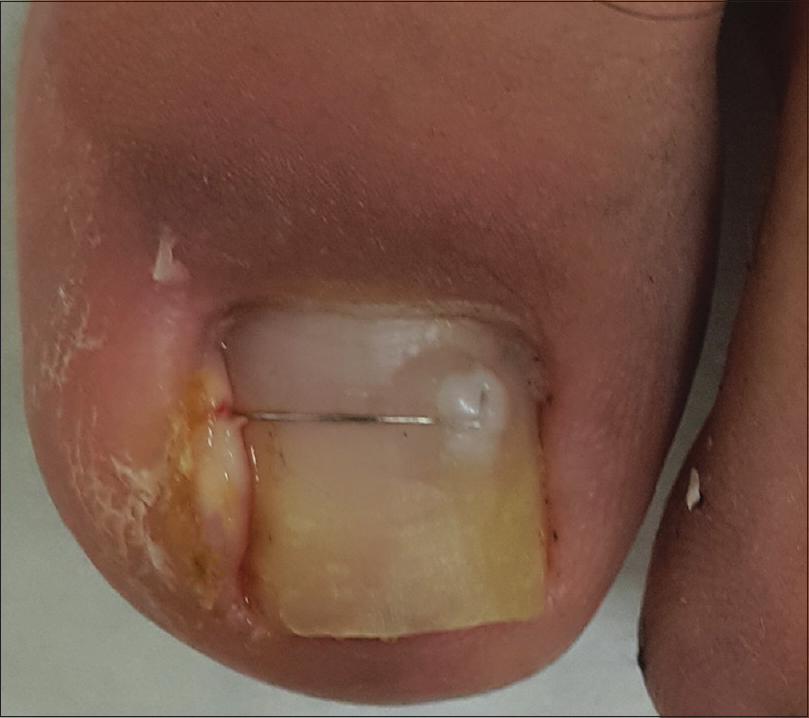 |
| Figure 1b: Granulation tissue progressed after 2 weeks owing to irritation from the wire |
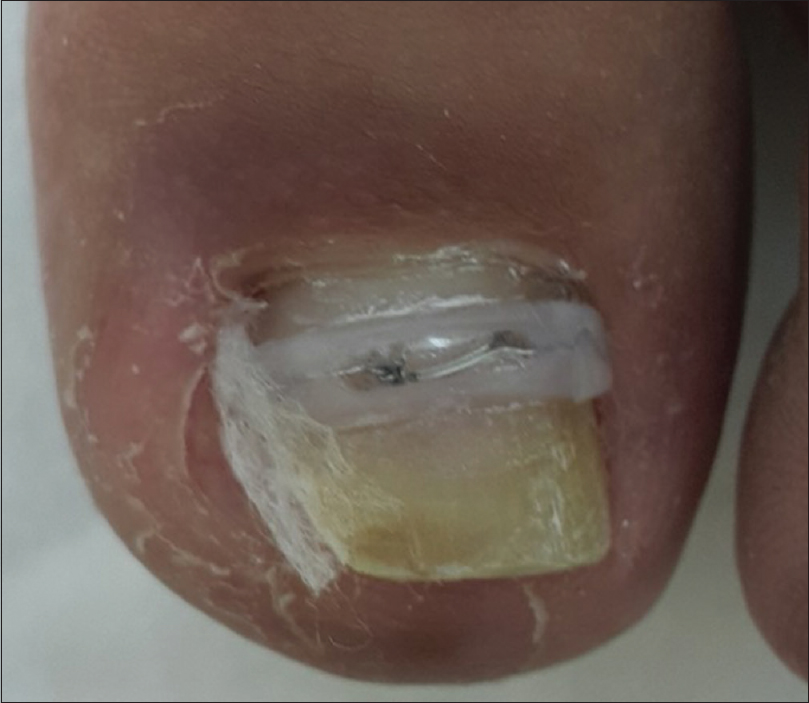 |
| Figure 1c: COMBIped brace was removed and Podofix brace was applied |
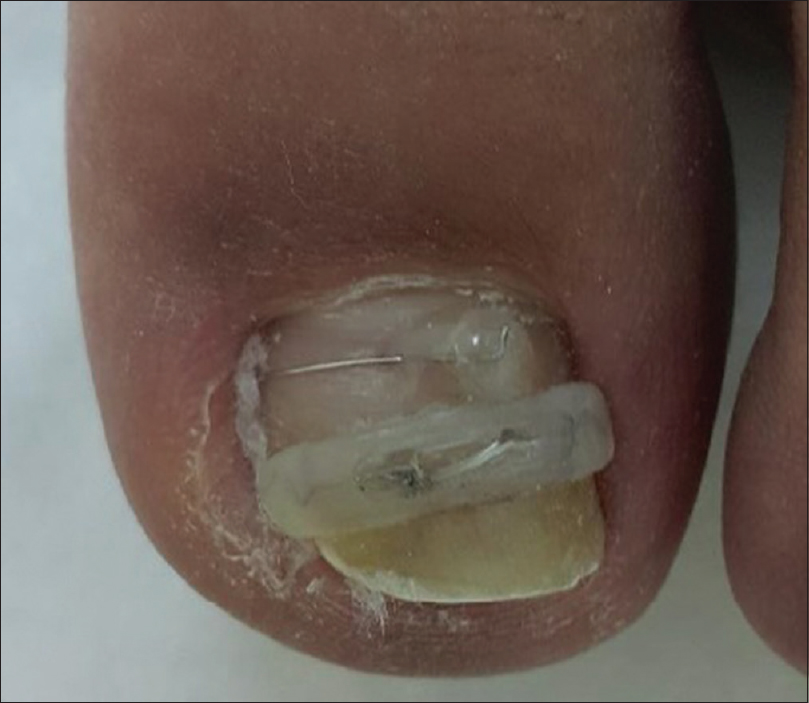 |
| Figure 1d: A new COMBIped brace was added after the granulation tissue totally resolved |
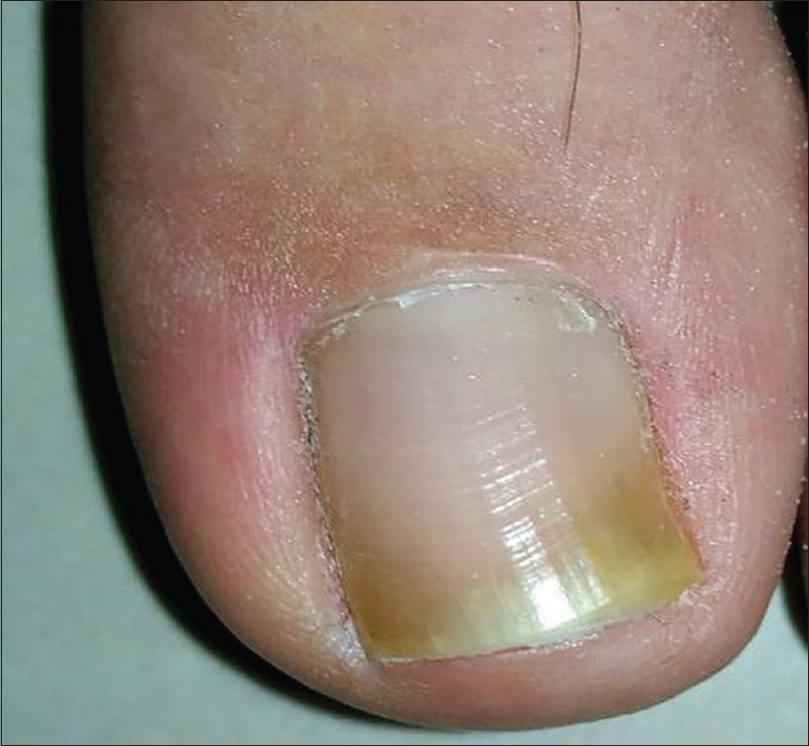 |
| Figure 1e: Ingrown toenails recovered |
A 32-year-old man suffered on and off for 1 year from a grade III ingrown toenail with periungual erythema, tenderness, and discharge on the right big toe [Figure 2a]. A Podofix brace was applied and 1st generation cephalosporin was prescribed for 1 week [Figure 2b]. After the peripheral infected/inflamed tissues recovered, a COMBIped brace was added to the medial side below the Podofix brace [Figure 2c]. The Podofix brace spontaneously dropped off, and the COMBIped brace was retained for 4 months [Figure 2d]. The ingrown nail on the lateral side of the right toenail recurred owing to the lack of COMBIped brace therapy on that side of the nail. A new COMBIped was applied for 2 months. After an 8-month treatment, the right big ingrown toenail was completely resolved [Figure 2e] without recurrence in the 4-month follow-up period.
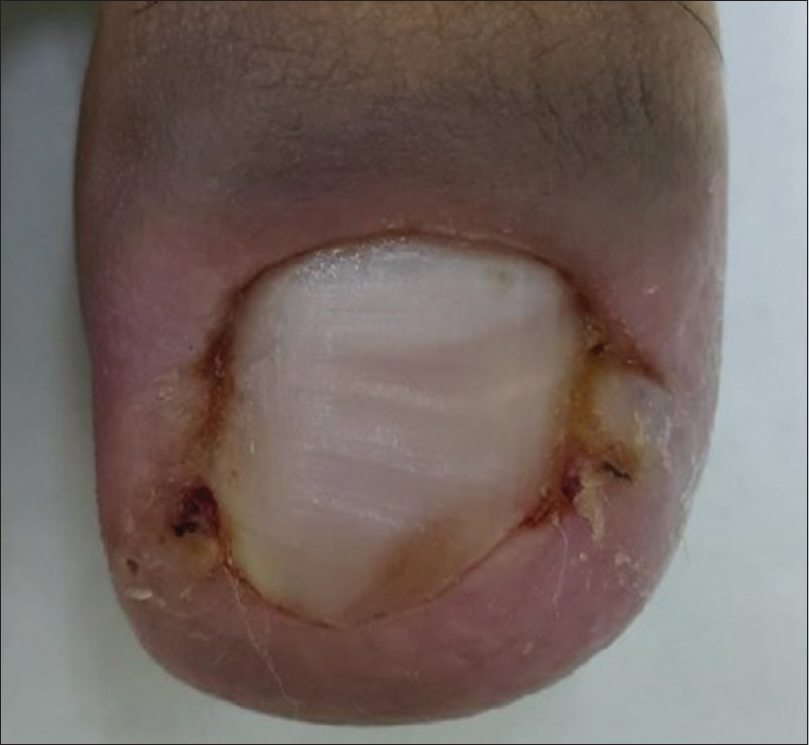 |
| Figure 2a: Chronic inflammed/infected nail fold due to recurrent ingrown toenail (before therapy) |
 |
| Figure 2b: Finished Podofix brace placement with thin gauze insertion |
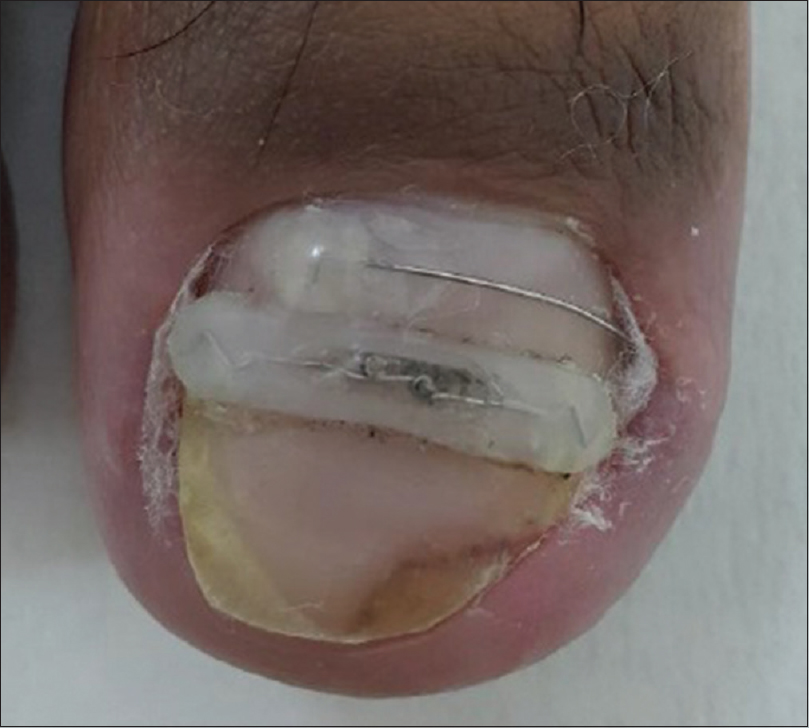 |
| Figure 2c: The COMBIped nail brace was placed under the Podofix brace |
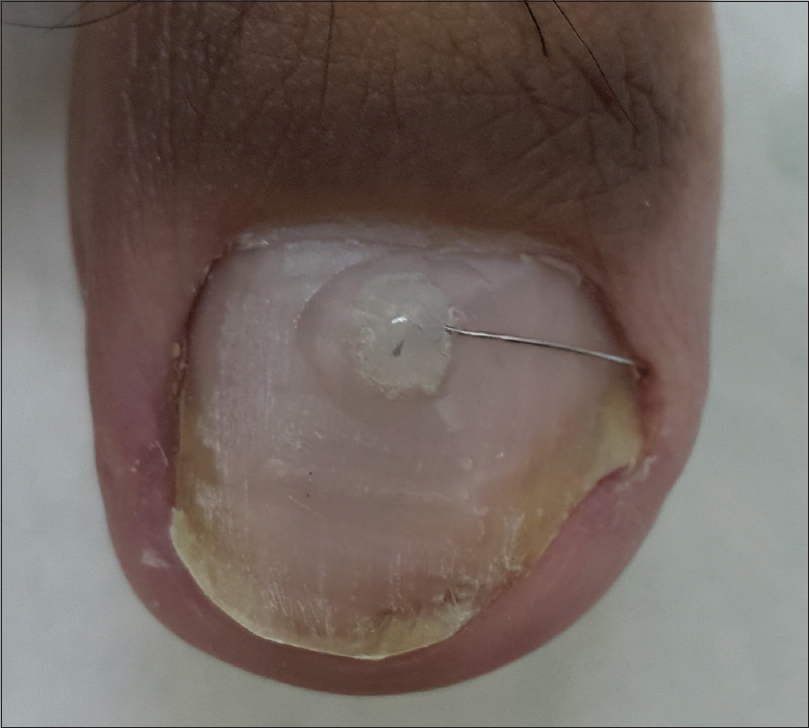 |
| Figure 2d: The medial side of right big toe was lift by COMBIped brace |
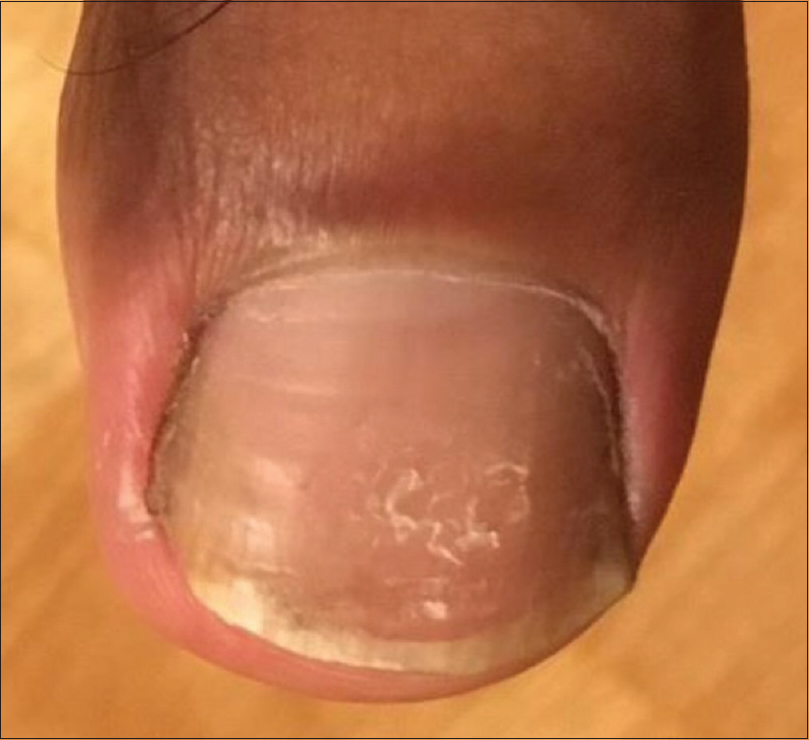 |
| Figure 2e: Ingrown toenails almost recovered with original fan-shaped nail (8 months after first time of therapy) |
Nail braces such as the VHO-Osthold brace [1] and Oniko nail brace [2] were both reported to be an alternative treatment to surgical procedures with similar efficacy but shorter time interval before returning to work. We summarized and compared the reported nail braces and similar devices in [Table - 1]. Most of the devices needed access to the nail rim during application. If there is severe inflammation or a large pyogenic granuloma (PG), accessing the nail rim is difficult and the inflamed tissue is easily irritated. The PG usually needs to be removed before applying the braces. The Podofix brace only attaches to the nail, and then, pulls up the nail edges to relieve pressure on the surrounding tissue without the need to access the nail rim. However, the Podofix brace is not strong enough to correct hard or severely curved nails similar to other devices. The COMBIped brace has a bending force on the nail via the restoring torque of the wire, facilitating the correction of severely deformed nails. This single-side nail brace functions in a manner similar to the Sogawa method, which can correct ingrown toenails in patients with involvement of only one side and in those with hard and curved nails.[3] However, the limitation of COMBIped brace, like most of other devices, is the need of an easily approaching nail rim.

By combining two types of nail braces, we were able to immediately treat patients, fasten the recovery of peripheral tissue, and instantly relieve pain without removing the PG and causing tissue damage. It is also important to remove a minimal portion of the ingrown nail to allow the PG to resolve more rapidly. Although complete recovery of ingrown toenail takes long time, wearing these braces did not cause discomfort. Longer use of nail braces helped maintain the shape of the nail and allowed better nail bed regrowth.
Here, we presented a new combination for treating complicated ingrown toenails without any tissue damage. Along with the development of nail braces, additional combinations could provide more comfortable and efficient therapy. A large-scale prospective study should be designed to verify the efficacy of such nail braces.
Financial support and sponsorship
Nil.
Conflicts of interest
There are no conflicts of interest.[4]
| 1. |
Harrer J, Schöffl V, Hohenberger W, Schneider I. Treatment of ingrown toenails using a new conservative method: A prospective study comparing brace treatment with Emmert's procedure. J Am Podiatr Med Assoc 2005;95:542-9.
[Google Scholar]
|
| 2. |
Guler O, Tuna H, Mahirogullari M, Erdil M, Mutlu S, Isyar M. Nail braces as an alternative treatment for ingrown toenails: Results from a comparison with the winograd technique. J Foot Ankle Surg 2015;54:620-4.
[Google Scholar]
|
| 3. |
Sano H, Oki K, Sogawa H, Ogawa R. The stainless steel wire-based method of sogawa effectively corrects severe ingrown nails. Plast Reconstr Surg Glob Open 2016;4:e846.
[Google Scholar]
|
| 4. |
Arik HO, Arican M, Gunes V, Kose O. Treatment of ingrown toenail with a shape memory alloy device. J Am Podiatr Med Assoc 2016;106:252-6.
[Google Scholar]
|
Fulltext Views
4,904
PDF downloads
909





